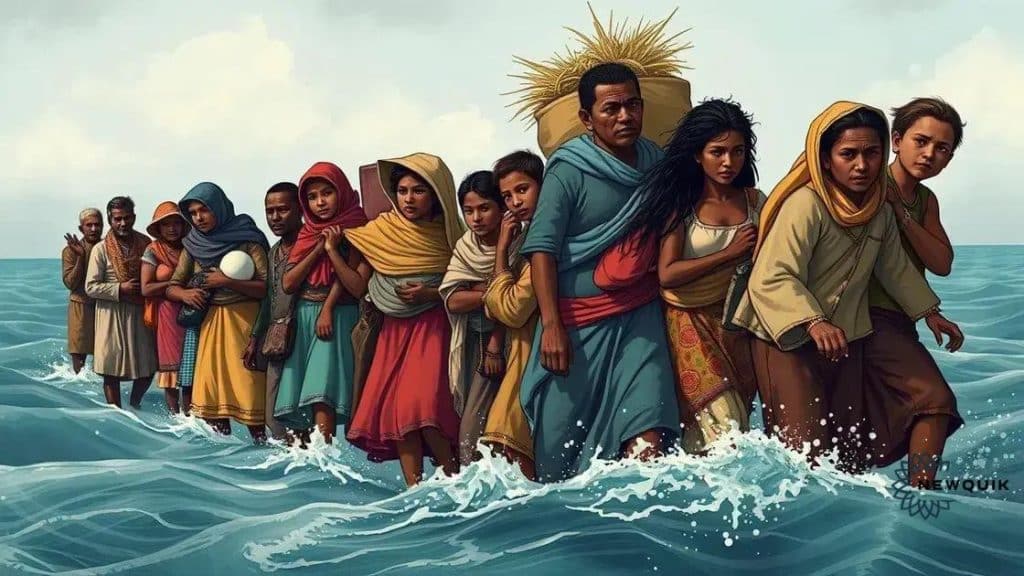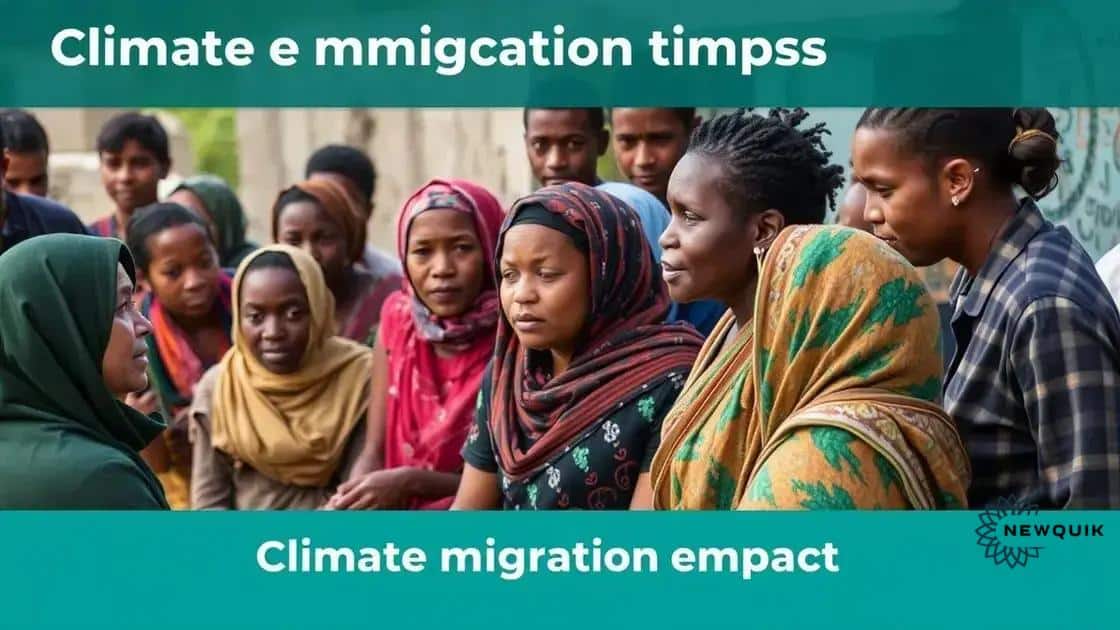Climate migration: the urgent need for action on displacement

Anúncios
Climate migration refers to the movement of people forced to leave their homes due to environmental changes like rising sea levels, extreme weather events, and resource scarcity, necessitating effective policies and community support to address their needs.
Climate migration is becoming an increasingly pressing issue as environmental changes displace millions of people worldwide. This topic raises critical questions about how communities can adapt and survive. Are we prepared for the challenges ahead?
Anúncios
Understanding climate migration trends
Understanding climate migration trends is essential to grasp the significant impact of environmental changes on communities worldwide. Climate migration refers to the movement of people forced to leave their homes due to sudden or gradual changes in their environment, such as rising sea levels, extreme weather events, and prolonged droughts.
As these changes become more severe, it’s crucial to analyze the trends that shape climate migration. Climate migrants often face numerous challenges as they seek safety and stability. Many are left vulnerable and require immediate assistance. By identifying the key factors driving this trend, we can better address the needs of affected populations.
Key Factors Influencing Climate Migration
Several environmental factors contribute to the migration of individuals and families. Understanding these elements helps us respond effectively to the ongoing crisis. Some of the main factors include:
Anúncios
- Sea Level Rise: Coastal communities are increasingly threatened by rising oceans. This leads to flooding and loss of land, forcing people to relocate.
- Extreme Weather Events: Hurricanes, floods, and wildfires destroy homes and disrupt lives. As these events become more intense, more people are displaced.
- Drought: Prolonged drought keeps crops from growing, leading to food shortages and water scarcity. Farmers often have no choice but to leave their land in search of better conditions.
These factors intertwine, creating complex challenges for affected communities. As climate change escalates, the number of climate migrants is expected to rise significantly. This trend poses not only humanitarian challenges but also socio-economic issues that require immediate attention and action.
Understanding the nuances of climate migration trends is critical as it sets the foundation for creating policies and solutions tailored to the needs of these vulnerable populations. It’s important for governments, NGOs, and the international community to work collaboratively in addressing this global challenge through research and actionable strategies.
Causes of displacement due to environmental changes
The causes of displacement due to environmental changes are vast and interconnected. Understanding these causes is crucial for addressing the needs of those affected. Environmental factors can force families and individuals to leave their homes, often without much choice or warning.
One significant cause is natural disasters. Events like hurricanes, floods, and earthquakes can devastate entire regions in moments. These disasters displace thousands, leaving them to seek refuge elsewhere. The aftermath can be chaotic as people try to rebuild their lives amidst destruction.
Long-Term Environmental Changes
In addition to sudden disasters, long-term changes also contribute to displacement. Rising temperatures and shifting weather patterns disrupt farming and livelihoods. This leads to food shortages and increasing competition for resources. As conditions worsen, communities find themselves unable to sustain their way of life. Many choose to leave in search of better opportunities and safer environments.
- Climate Change: Gradual changes in climate can lead to more severe droughts and floods, significantly impacting agriculture.
- Sea Level Rise: Coastal areas face erosion and flooding, making them increasingly uninhabitable.
- Resource Scarcity: Water shortages and loss of arable land drive people to migrate to areas with better resources.
These factors do not stand alone; they often interact in complex ways, exacerbating the situation. For example, a prolonged drought may lead to crop failure, causing a spike in food prices and triggering economic instability. Communities already struggling may face the added pressure of having to leave due to these compounded effects.
Understanding the intricacies of these causes helps inform policies aimed at supporting affected populations. By addressing both immediate and long-term challenges, societies can better equip themselves to handle the realities of climate displacement.
Impacts on affected communities

The impacts on affected communities due to climate migration can be profound and lasting. When people are forced to leave their homes because of environmental changes, it affects not only the individuals and families involved but also the communities they leave behind and the ones they join.
One major impact is the loss of cultural identity. Communities that lose members may struggle to maintain their traditions and ways of life. As families move to new areas, they often face challenges in integrating into different cultures and communities. This can lead to a sense of isolation for both the migrants and the host community.
Economic Challenges
Climate migration can also create economic challenges. In areas experiencing an influx of migrants, resources can become strained. Housing shortages, increased demand for services, and job competition can all lead to tensions. Host communities may find it difficult to accommodate newcomers, which may result in conflict.
- Increased Pressure on Resources: Basic necessities like water and food become scarce, making it harder for everyone.
- Job Competition: With more people looking for work, the job market may become overcrowded, leading to higher unemployment rates.
- Healthcare Strain: As more people arrive, healthcare systems can become overwhelmed, reducing access for all.
Beyond economic challenges, the psychological effects on both migrants and host communities are significant. Many migrants experience trauma from their displacement. Host communities may also feel the pressure of adapting to new dynamics, leading to stress and anxiety.
Moreover, the social fabric of communities is altered. Long-standing relationships may become strained as newcomers and residents navigate their differences. Understanding these impacts highlights the need for policies to support integration and community resilience.
Policy responses to climate-driven displacement
The policy responses to climate-driven displacement are crucial for addressing the challenges faced by affected communities. With increasing numbers of people forced to migrate due to environmental changes, effective policies are needed to help both migrants and host communities.
One key policy response is the development of comprehensive migration frameworks. These frameworks should focus on the needs of climate migrants and ensure their rights are protected. Governments need to collaborate at local, national, and international levels to create inclusive policies that facilitate safe migration.
Enhanced Support for Affected Communities
Providing support for communities that receive climate migrants is equally important. Many host communities face pressure on their resources. Policies should aim to enhance infrastructure and services in these areas. This can include:
- Investment in Housing: Building affordable housing options to accommodate new arrivals can reduce housing shortages.
- Education and Training Programs: Offering educational resources helps migrants integrate and find employment more quickly.
- Public Health Services: Improving healthcare access minimizes health risks for both migrants and the host population.
Additionally, policymakers should focus on climate change adaptation and mitigation strategies. These strategies help communities prepare for future environmental challenges, reducing the number of people forced to migrate.
Another effective approach is the implementation of disaster risk reduction policies. By investing in early warning systems and infrastructure improvements, governments can help communities withstand natural disasters and minimize displacement. This proactive stance is vital for creating resilient communities.
Lastly, involving stakeholders—such as local governments, NGOs, and community organizations—in the policy-making process can lead to more effective and comprehensive solutions. Engaging these groups ensures that the voices of those affected by climate displacement are heard and considered.
Future outlook for climate migrants
The future outlook for climate migrants is evolving as climate change continues to impact communities worldwide. Understanding this outlook is essential to prepare for the challenges and opportunities that lie ahead.
As climate change accelerates, the number of climate migrants is expected to rise significantly. More people will be forced to leave their homes due to factors like rising sea levels, extreme weather events, and prolonged droughts. These conditions will lead to greater disruption and displacement.
Increased Migration Trends
Experts predict that certain regions will experience higher migration rates. Areas such as small island nations will face severe threats from rising seas, leading to a desperate need for relocation. Moreover, regions already dealing with economic difficulties may struggle to cope with an influx of migrants.
- Urbanization: Many migrants will flock to cities in search of better opportunities, leading to overcrowded urban areas.
- New Migration Pathways: Climate change may create new migratory routes and patterns as people seek safety and resources.
- Legal Frameworks: As migration increases, there will be a growing need for international agreements to protect the rights of climate migrants.
In addition to rising numbers, the challenges faced by climate migrants will also evolve. Access to basic needs such as housing, healthcare, and education will become increasingly important. Addressing these needs will require significant planning and investment from governments and organizations.
Moreover, the integration of climate migrants into host communities presents both challenges and opportunities for economic growth. Host communities may benefit from a diverse workforce and new ideas. However, tensions may arise if competition for jobs and resources intensifies.
Ultimately, the outlook for climate migrants will depend heavily on the actions taken today. Proactive policies focusing on adaptation, resilience, and support for affected communities will play a crucial role in shaping a better future for all.
As climate migration continues to grow, it is vital to address the challenges faced by those affected. Understanding the factors driving climate displacement and implementing proactive policies will be crucial for creating a sustainable future for all. By supporting both migrants and host communities, we can foster resilience and promote inclusion. Collaboration among governments, organizations, and communities will shape effective solutions and ensure that the rights and needs of climate migrants are met. Our collective actions today will define the outlook for tomorrow.
FAQ – Frequently Asked Questions about Climate Migration
What is climate migration?
Climate migration refers to the movement of people forced to leave their homes due to environmental changes, such as rising sea levels, extreme weather events, and droughts.
What are the main causes of climate displacement?
The primary causes include natural disasters, long-term climate change impacts, resource scarcity, and economic instability resulting from environmental changes.
How can communities support climate migrants?
Communities can support climate migrants by providing access to housing, healthcare, education, and job opportunities, while fostering an inclusive environment.
What role do policies play in managing climate migration?
Effective policies are crucial for protecting the rights of climate migrants, ensuring access to services, and promoting cooperation between host and migrant communities.





